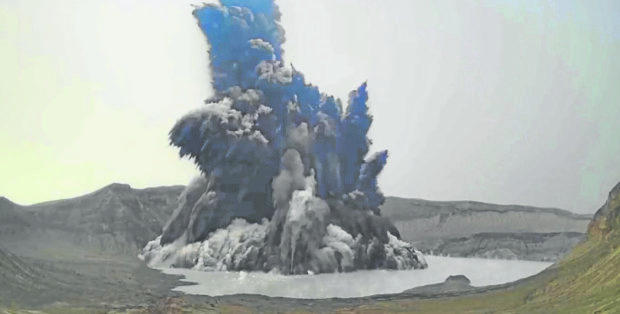Taal alert up after 5-min eruption

OMINOUS SIGHT A dark plume of steam, rocks and magma fragments rises about a kilometer high from the main crater of Taal Volcano on Thursday afternoon, sending residents of nearby towns into panic. Phivolcs raised the alert status of Taal to Level 3, indicating magmatic unrest, and recommended the evacuation of residents in two Batangas towns. —VIDEOGRAB FROM PHIVOLCS
With Taal Volcano placed on alert level 3 following a five-minute eruption on Thursday afternoon, volcanologists have recommended the evacuation of residents in Agoncillo and Laurel towns in Batangas province.
The phreatomagmatic eruption—an explosion that happens when new magma interacts with water—came days after the Philippine Institute of Volcanology and Seismology (Phivolcs) recorded increasing levels of sulfur dioxide (SO2) emissions from the volcano’s main crater.
The volcanic smog, or vog, spread to the National Capital Region, about 65 kilometers away, shrouding the Metro and nearby provinces in a haze early this week.
Thursday’s explosion occurred from 3:16 p.m. to 3:21 p.m. and produced a dark plume that rose a kilometer high.
President Duterte, however, downplayed the eruption, saying it was “not a grave concern” at the moment and that measures for a government response were in place.
“We will raise the alert on the level that it should. Now it’s just a rumbling and it’s spewing. I don’t know if it’s really the ashes. They say we are affected but it’s not really a grave concern for us at this time,” Mr. Duterte said during the inauguration of the Light Rail Transit 2 extension line on Thursday.
The President said aid for affected residents from the Department of Social Welfare and Development was already in position if Taal erupts.
“It could get worse, but I said there will be instant gratification because there are workers on the ground ready,” Mr. Duterte said.

Not expecting ashfall
Science Undersecretary Renato Solidum, the Phivolcs officer in charge, said the volume of ash generated by Taal’s eruption was yet to be determined but that it was mostly contained in the main crater. Since the plume from the explosion did not rise very high, he said, the ashfall was not expected to threaten nearby towns and provinces.
Still, the volcano’s heightened unrest “drove some residents of Talisay town into panic,” according to Peter John Mirania, Talisay’s disaster risk reduction and management (DRRM) official. He said the agency has been spreading information on social media to calm down the locals and assure them of the DRRM’s readiness. Evacuation centers have been also been identified, he said.
Cavite Gov. Juanito Victor Remulla said the provincial government was in close coordination with officials of the towns surrounding the volcano and had food stocks enough for five days and over 100 vehicles for evacuation. “Antigen test kits are also on standby for the evacuation areas,” Remulla announced on his Facebook page.
Plan set since March
In a March 2 meeting between officials from several municipalities in Batangas and Cavite, an evacuation plan was mapped out in case the volcano acted up again after its last eruption in January 2020.
Following the elevated alert status, Phivolcs has recommended barring entry to Taal Volcano Island, a permanent danger zone, as well as the evacuation of residents in high-risk barangays near Taal, particularly Banyaga and Bilibinwang in Agoncillo, and Gulod, Boso-boso and the lakeshore portion of Bugaan East in Laurel.
Philippine National Police chief Guillermo Eleazar on Thursday placed its forces in the Calabarzon (Cavite, Laguna, Batangas, Rizal and Quezon) region on alert for the possible mass evacuation.
Batangas Gov. Hermilando Mandanas said over 3,500 families, or more than 14,500 individuals, were expected to be evacuated from these areas.
Phivolcs said current parameters do not point to a similar explosive eruption that happened in 2020, which forced hundreds of thousands of families to flee their homes.
But Solidum cautioned that the scenario could still change should there be a new buildup and intrusion of magma from beneath the volcano’s edifice. This could lead to another escalation in its alert status.
Because of the volcano’s continuing emission of SO2 gases—as much as 13,287 tons just before the Thursday eruption—Solidum said people who choose not to evacuate are advised to stay indoors to limit exposure to the acidic gas and the volcanic smog or vog. Disaster authorities in Batangas also reminded the public to wear N95 face masks for protection and to drink plenty of water. INQ
RELATED VIDEO
